KBR Equestrian Safety Series
"SAFETY AROUND HORSES"
By Willis Lamm
|
Horses are born survivors. They are amazingly successful in virtually any
habitable wild environment. Their success is greatly due to their physical
design and a number of instinctive behaviors that serve them well in hostile
territory. These behaviors exist in every horse and can unexpectedly be brought
out by an unwitting human.
Secrets to safe horse handling include understanding what stimuli trigger certain horse
responses, and how a horse communicates his concerns and what he intends to do.
|
Horse & human both trying to make a point.
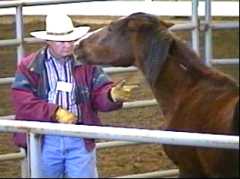
|
|
Physical Characteristics
Most horses are substantial in size, are good runners and have excellent hearing
and smell. The horse has monocular vision; his eyes are set on the sides of
his head. Because of this design he loses a great deal of depth perception
but he gains almost 360 degrees of vision. He has only two blind spots; a small
one at the tip of his nose and a larger one directly behind his rump.
A horse is designed to flee from danger however he is well equipped to fight
if he feels threatened and believes that has no clear exit. He can kick, bite and strike
with his forelegs.
|
Alert for any danger
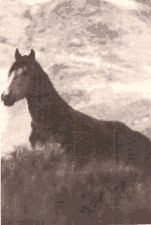
|
|
The "Alarm Center"
Picture the bucolic scene of a horse grazing alongside his herd. All
is well but the brush rustles at the edge of the meadow. The horse doesn't
know what made the brush rustle so a certain amount of stress is generated
in his "alarm center." If the rustling stops the horse's alarm center
will go back into stand-by mode. If the rustling continues, one of three
predictable outcomes will probably occur. The horse's appropriate response
is key to his survival
|
Even in a domestic environment inherent instincts
can be seen. Here the lead mare is taking a turn as "sentinel."
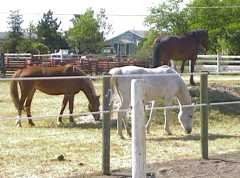
|
The three probable scenarios:
- The rustling continues. The horse continues to generate stress until his
flight threshold is reached and he gallops away.
- The horse's anxiety is confirmed by the actual smell, sight or sound of
a predator and he gallops away.
- Something familiar, such as the head of another horse popping up from the
brush, satisfies his anxiety, releases his stress and his alarm center
goes back into stand-by mode.
|
Left Brain / Right Brain
Horses' brains are similar to other mammals. The left hemisphere controls reasoning
and cognitive activities. The right hemisphere controls instinctive and survival
oriented reactivity. Horses are prey animals. They eat grass and other animals eat
them. As a matter of survival in the wild their right brain hemispheres must be able
to trigger an immediate protective response once a certain stress level is reached.
|
This horse has reached a right brain "survival" response
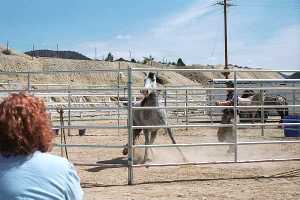
|
|
Flight or Fight
Horses are built to run and will ordinarily choose flight to avoid danger.
This defense is well suited in open country, but is generally not practical in
the close confines of human captivity.
If the horse can't see a flight path or if he is defending something (e.g., a
mare defending a foal or a stallion defending his band from another suitor)
the horse can inflict great injury with his hooves and teeth.
|
Flight is generally a horse's first choice
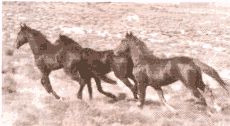
|
|
Natural Aggression
Horses can be naturally aggressive with other horses. A strong herd
social order is important to survival. Those with strongest wills and
physical abilities are the leaders. Determining the rankings can at
times be quite physical.
Horses can be aggressive over food, especially if they are fed periodically
rather than grazing all day and when they have to compete with other horses
for their share. They can also be aggressive about protecting their buddies.
Stallions can be particularly aggressive about protecting their mares.
|
Horses can be very aggressive in establishing the herd hierarchy
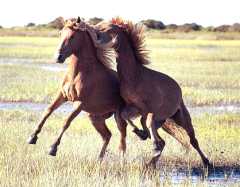
|
|
Under the right circumstances these aggressive behaviors can be transferred
against humans.
|
|
Maternal / Paternal Instincts
Most horse losses to predators involve foals. Foals can even be injured or killed by
other horses. Most mares, therefore, are very protective of their young, including
defending them from unfamiliar or aggressive acting horses.
In the wild foal care is also undertaken by "bachelors" who earn their right to
continue as part of a band by helping keep watch over younger horses. Young
bachelors often remain with the group until they are perceived as threats who may
take the band stallion's mares.
|
Even "bachelors" have a natural instinct to protect youngsters

|
Return to Training Section
Go To  KBR Horse Net KBR Horse Net
Important Note: If you take on the project of developing an untrained horse, everybody will want
to give you advice. Don't act on any advice, including the ideas offered in this site, unless it makes
sense to you and fits your individual situation. Your abilities and the sensitivities of your horse(s)
may differ from the examples given. Be alert and rational with your actions so neither you nor your
horse will get hurt. This information is offered as illustrations of what we do and the reader must
apply common sense since he or she is solely responsible for his or her actions.
Happy trails!
KBR Horse Safety Information, © 1997
Lamm's Kickin' Back Ranch and Willis & Sharon Lamm. All rights reserved. Duplication of any of
this material for commercial use is prohibited without express written permission.
This prohibition is not intended to extend to personal non-commercial use, including sharing
with others for safety and learning purposes, provided this copyright notice is
attached.
Email us to submit comments or
request reproduction permission.
|